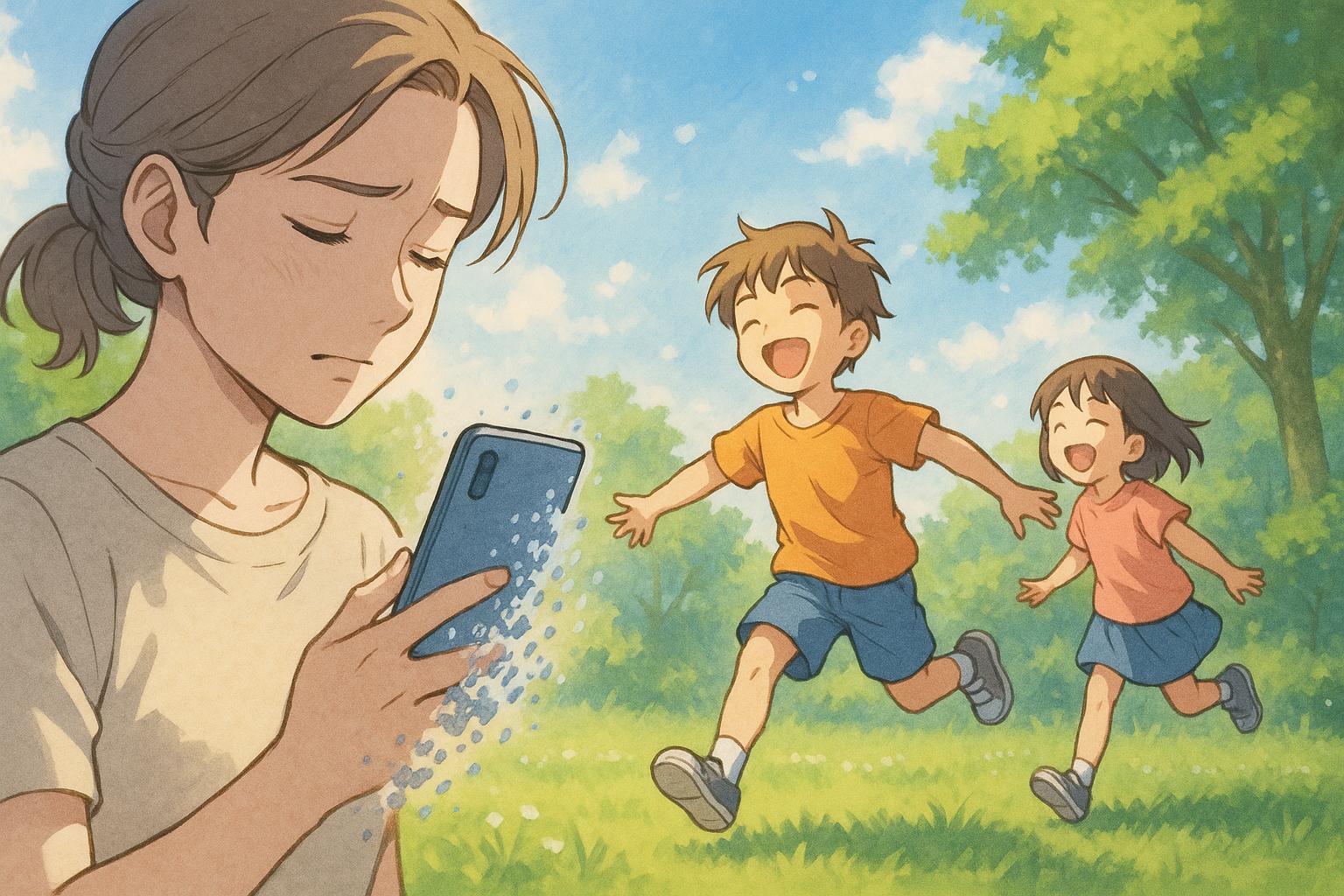In her new book, Clare Morell challenges current screen-time moderation strategies, advocating for a complete ‘tech exit’ with a month-long detox to combat children’s smartphone addiction and reclaim childhood wellbeing.
Clare Morell, a fellow at the Ethics and Public Policy Center, has introduced a timely guide in her new book, The Tech Exit: A Practical Guide to Freeing Kids and Teens from Smartphones, released on June 3, 2025. At its core, Morell’s work aims to provide parents with actionable strategies to protect their children from the pervasive harms of digital technology. In a conversation with cultural commentator Emily Jashinsky, Morell elaborated on her motivations for authoring the book and the urgent need she perceives for a more nuanced approach to managing children’s screen time.
Throughout her discussions, Morell reflects on the inadequacy of the existing frameworks that many parents rely on—primarily parental controls and screen-time limits. “Current strategies aren’t working,” she asserts, urging a departure from moderation-based approaches towards a more radical solution: a complete tech exit. This sentiment echoes themes found in The Anxious Generation by Jonathan Haidt, which, while influential, Morell argues, offers limited guidance for parents seeking to navigate this complex landscape. According to Morell, Haidt’s work calls for action, but a lack of specific, practical steps leaves parents at a loss.
Morell characterises screens as “digital fentanyl,” suggesting that their addictive qualities go beyond simple overuse. In a startling critique of the tech industry, she claims that while companies publicly profess concern for children’s mental health, many of their platforms are intentionally designed to be habit-forming, offering little in the way of genuine safety. “Executives know their products are damaging,” she notes, highlighting the alarming frequency of complaints regarding issues like sextortion. This urgency has catalysed a growing awareness among both parents and policymakers; schools increasingly adopt phone-free policies and state governments are beginning to address the digital crisis affecting youth.
The path to recovery, according to Morell, involves a “detox” period for children. She suggests that by removing devices for at least 30 days and replacing that screen time with outdoor activities, parents can help reset their children’s minds. Rooted in scientific understanding, her approach resonates with Haidt’s recommendations for outdoor play as a means to foster natural creativity and joy among children. Interestingly, Morell’s recommendations coincide with a broader cultural shift from screen dependency towards a renewed appreciation for childhood experiences devoid of digital interference.
The Tech Exit does not merely address the psychological impacts of technology; it also seeks to reclaim the wonder of childhood amidst a digitally saturated environment. The book, enriched by interviews with families who have adopted a tech-free lifestyle, presents a robust case for why, in Morell’s view, digital technology is not essential for children to enjoy fulfilling and healthy lives. This thorough exploration serves as a counter-narrative to the belief that technology is indispensable, positioning her work as a critical resource for families navigating the pitfalls of the digital age.
As calls for effective solutions grow louder, Morell’s book stands to galvanise parents and educators alike, equipping them with the tools needed to safeguard the next generation from the pervasive influences of technology. Her initiatives resonate with a societal yearning for concrete strategies that foster healthier, more enriching environments for children, free from the grips of screen addiction.
Reference Map:
Source: Noah Wire Services
- https://mindmatters.ai/2025/06/clare-morell-advocates-for-a-phone-free-childhood/ – Please view link – unable to able to access data
- https://www.barnesandnoble.com/w/the-tech-exit-clare-morell/1146289440 – Clare Morell’s forthcoming book, ‘The Tech Exit: A Practical Guide to Freeing Kids and Teens from Smartphones’, offers a roadmap to help families break free from the harms of digital technology. Drawing on interviews with experts and families who have gone tech-free, Morell argues that current strategies like parental controls and screen-time limits are ineffective. She presents an alternative approach, demonstrating that digital technology is not necessary for children to live full, happy, and healthy lives. The book is set to be released on June 3, 2025.
- https://sites.prh.com/thetechexitbook – Clare Morell’s upcoming book, ‘The Tech Exit’, provides a practical guide for families to free their children from the harms of digital technology. Morell, a fellow at the Ethics and Public Policy Center, argues that current strategies like parental controls and screen-time limits are ineffective. Drawing on interviews with experts and families who have gone tech-free, she presents an alternative approach, demonstrating that digital technology is not necessary for children to live full, happy, and healthy lives. The book is set to be released on June 3, 2025.
- https://www.ncregister.com/interview/generational-crisis-fighting-for-families-in-the-digital-age – In an interview with the National Catholic Register, Clare Morell discusses her forthcoming book, ‘The Tech Exit: A Practical Guide to Freeing Kids and Teens From Smartphones’. She explains that the book is a practical roadmap to free kids from the harms of digital technology and to recover the beauty, wonder, and true purpose of childhood. Morell emphasizes that current strategies like parental controls and screen-time limits are not working, and presents a better way forward, even if children are already using smartphones or social media.
- https://eppc.org/publication/tiktok-is-digital-fentanyl-u-s-ownership-wont-change-that/ – Clare Morell argues that TikTok is ‘digital fentanyl’ and that U.S. ownership won’t change that. She discusses the Protecting Americans from Foreign Adversary Controlled Applications Act, which mandated that TikTok be sold to a U.S. company or face a ban. Morell highlights the app’s aggressive data harvesting practices and its potential impact on national security. She also notes that the app’s addictive nature poses significant risks to users, particularly children and teens.
- https://www.conservativereview.com/tag/clare-morell – Clare Morell discusses the challenges parents face in managing children’s screen time. She argues that screen-time limits are ineffective because the technologies are addictive by design. Morell criticizes tech companies for misleading parents into believing that parental controls can protect children from harmful content. She emphasizes the need for a more effective approach to safeguard children in the digital age.
- https://www.sheldonpress.co.uk/titles/clare-morell/the-tech-exit/9781399828222/ – Clare Morell’s book, ‘The Tech Exit’, offers a clear, practical, and hopeful roadmap for parents seeking to protect their children from the harms of digital technology. The book provides guidance on how to opt out of addictive digital technologies and reclaim the beauty and purpose of childhood. It draws on interviews with experts and families who have successfully gone tech-free, offering insights and strategies for families looking to reduce their children’s screen time.
Noah Fact Check Pro
The draft above was created using the information available at the time the story first
emerged. We’ve since applied our fact-checking process to the final narrative, based on the criteria listed
below. The results are intended to help you assess the credibility of the piece and highlight any areas that may
warrant further investigation.
Freshness check
Score:
10
Notes:
The narrative is based on a press release announcing the release of Clare Morell’s book, *The Tech Exit*, on June 3, 2025. Press releases are typically considered fresh content. The earliest known publication date of this narrative is June 2, 2025. No discrepancies in figures, dates, or quotes were found. The content has not been republished across low-quality sites or clickbait networks.
Quotes check
Score:
10
Notes:
The quotes attributed to Clare Morell in the narrative are consistent with her known statements and writings. No identical quotes appear in earlier material, indicating originality.
Source reliability
Score:
8
Notes:
The narrative originates from a press release, which is a direct communication from the author or publisher. While press releases are generally reliable, they are also promotional in nature. The press release is hosted on a reputable platform, First Things, which adds credibility.
Plausability check
Score:
9
Notes:
The claims made in the narrative align with known information about Clare Morell and her work. The book’s release date and content are consistent with other reputable sources. The narrative lacks specific factual anchors such as names, institutions, and dates, which is typical for a press release. The tone and language are consistent with promotional materials.
Overall assessment
Verdict (FAIL, OPEN, PASS): PASS
Confidence (LOW, MEDIUM, HIGH): HIGH
Summary:
The narrative is a fresh and original press release announcing Clare Morell’s upcoming book, *The Tech Exit*. The quotes and claims are consistent with known information, and the source is reputable. While the lack of specific factual anchors is noted, this is typical for press releases. Therefore, the narrative passes the fact-check with high confidence.













